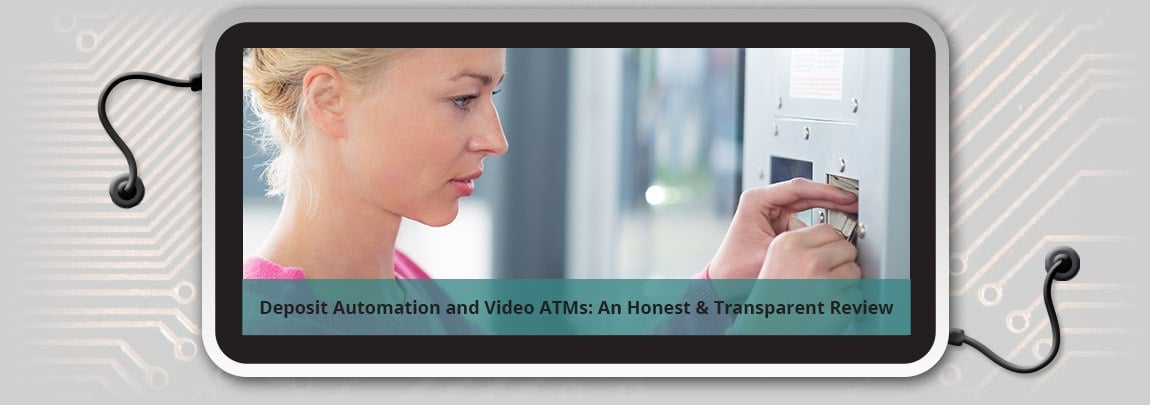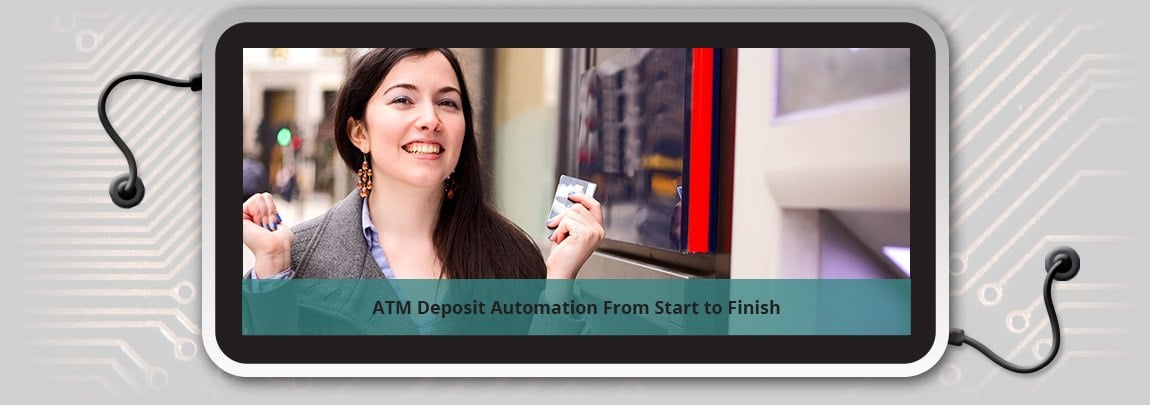Deposit Automation and Video ATMs: An Honest Review
Technology has revolutionized the banking industry, leaving financial institutions wondering which advancements make sense for their unique needs....
.jpg)
.jpg?width=2736&name=shutterstock_1206391666%20(1).jpg) ATMs, or Automated Teller Machines, have been around a long time now in the banking space. They have provided access to cash for clients for decades, especially when the branch was closed. As technology has advanced, more and more Financial Institutions are not only dispensing cash, but accepting deposits at ATMs. In this article we’ll address what ATMs cost and what factors drive those costs.
ATMs, or Automated Teller Machines, have been around a long time now in the banking space. They have provided access to cash for clients for decades, especially when the branch was closed. As technology has advanced, more and more Financial Institutions are not only dispensing cash, but accepting deposits at ATMs. In this article we’ll address what ATMs cost and what factors drive those costs.
At first we need to determine what kind of functionality we are looking to offer our customers or members at the ATM. If we are simply looking to dispense cash at the ATM and do so securely, the costs are fairly straightforward. The typical cash dispense only branch ATM ranges from $15,000-$40,000 depending on which manufacturer you select. These types of ATMs come in a variety of formats such as Island Drive Up or Free standing units, Through the Wall Walk up, Through the Wall Drive up and Lobby ATMs.
Many clients also look to place ATMs in SEG groups or other off-premise locations to be of service to key customer groups of the institution. These ATMs are relatively inexpensive and range from $4000-$14,000, again depending on manufacturer. This type of ATM is great to add additional touchpoints to your area and drive loyalty and brand recognition for a fraction of the cost of the typical branch ATM.
If you’re looking to add deposit automation or image deposit taking at the ATM, the costs do go up. Just 4-5 years ago it was roughly double the cost to add deposit automation to an ATM. As time has progressed the gap has narrowed quite a bit to add that functionality as it has become much more widespread in the market. The typical cost of a deposit automated ATM ranges from $36,000-$55,000.
One of the key factors driving deposit automation is transaction migration. The typical cost of a teller transaction done inside the branch is $3.50-$4.50. The typical cost of a deposit automated transaction, done in self service at the ATM, is $.50-$.75. So as FIs look to move more transactions off the teller line to a self-service channel to focus branch employees on relationship building, that cost save becomes a key driver to efficiency ratio improvement.
Lastly, extra components like how many cassettes you need to dispense from, what type of lock you put on the ATM, do you want ant-skimming technology or some other more custom card reader solution can drive costs towards the higher end of the range.
Most ATMs are running on a Windows operating system platform. However, typically each manufacturer has their own software stack of ATM applications to run. For Hyosung ATMs, this is called Moniplus 2S, for NCR ATMs traditionally it’s been called Aptra Edge, but now it will be Activate Enterprise and Diebold ATMs also traditionally ran on Agilis software, but they have migrated to Phoenix Vista.
The typical ATM application for cash dispense only ATMs runs about $1600-$2500 per ATM. If you wish to add deposit automation functionality that shifts the range to $2200-$4000 per ATM. If you plan to use deposit automation, you’ll also need a consolidator server solution to get the images from the ATM to the backend proof department. Those ATMs also need and agent to deliver the image files to the server. That agent typically runs $600-$1000 per ATM.
A consolidator server does exactly what it sounds like it should do. The server “consolidates” the image files from 1 to many ATMs and puts the data into a digestible format for the backend proof department. The standard is X9.37, which is the FED standard that came out after 9/11/2001. Consolidator servers are normally priced as a purchase or a hosted SaaS model. Typical costs to purchase a server ranges from $15,000-$30,000 and has a lower ongoing maintenance cost. This is best if you plan to have more than a handful of ATMs taking deposits. A hosted model normally has a setup fee ranging from $3000-$5000 and then a per month charge per ATM, which includes software and agent costs. Typically that ranges from $250-$325 per month per ATM. This is normally best for smaller fleets or based on IT strategy, it can be a way to outsource those resources off the internal IT infrastructure.
Getting an ATM brought live on site takes some careful planning and a lot of pieces coming together for success. For a quick checklist of ATM installation guidelines click here. Working with the ATM processor or switch, is crucial for timing and successful load sent to the ATM for bring live. Also using qualified riggers to set the ATM in place and safely remove the old ATM, if applicable, is a valuable step in the project chain.
Freight for most ATMs ranges from $700-$1200 depending on your part of the country and where the ATM is shipping from. Typical rigging costs, or physical installation costs range from $1000-$2000, again depending on site type or geography. Lastly, bringing the ATM live with a technician ranges from $500-$1000 depending on software load type and complexity. Overall typically ATM installation costs range from $2500-$4000, but can be higher based on construction costs or other site prep factors ahead of showing up to site.
There are several factors that drive maintenance cost around ATMs. These factors include hours of coverage, First and Second Line Service, Managed Services and software maintenance. Let’s unpack these typical costs:
Coverage Hours
There are several standards that most FIs look at from a service coverage standpoint. Monday-Friday 8am-5pm is a standard coverage range, typically associated with when the branch staff is present at the location. Oftentimes this is popular with cash dispense only ATMs or in high density areas where if an ATM is down, another one is very likely nearby. This is typically the lowest cost option for maintenance coverage.
Secondly, we get into 7 day coverage hours, which typically result in times like 8am-8pm or 8am-11pm. With ATMs being a big channel for customers when the branch is closed, this coverage model is becoming more and more popular to ensure devices stay functioning. This can be especially crucial in the community bank and credit union space where there may not be another ATM local, therefore making each site a crucial touchpoint for clients to access funds and make deposits after hours.
There are several other more custom flavors like Monday-Friday 8am-8pm, or 7 days a week 24x7, but those are rare instances from our experience.
The typical cost delta to go from Monday-Friday 8am-5pm to 7 day 8am-8pm is normally around 20-25% in the market. Maintenance companies when offering extended hours have to have employees on call and typically being paid overtime to cover the extended hours. There may also be higher insurance costs to cover access to ATMs without branch staff present, all of those factors lead to that increase in cost.
First and Second Line Maintenance
The easiest definition of First Line Maintenance or FLM is work performed on the ATM that doesn’t require a tool. These are things like clearing note jams, paper jams, deposit jams, rebooting the ATM, working on the network router, etc. This is an optional service for most companies and ranges from $600-$1300 per ATM per year on average. Many institutions essentially use their branch staff to perform FLM functions to save that cost. However, as more FIs shift to reduced staffing models and focus on better relationship development inside, many are utilizing FLM to not have staff deal with the ATM at all. This saves employee exposure from a safety perspective and staff time.
Second line maintenance is the key parts repair functionality with taking care of the ATM machine. Parts have gotten more expensive and modular, therefore making second line maintenance a key value for most FIs. For cash dispense only ATMs Second Line Maintenance typically costs between $1500-$2400. If you are running deposit automation likely costs are $3600-$5000 for SLM coverage. Again, SLM costs vary with coverage hours.
Software Maintenance
Software maintenance covers updates and upgrades to the software environment on the ATM. Mostly focused around the ATM application as new features or patches are rolled into the software to offer enhanced functionality or stability with specific ATM switches. Now that you know what the typical software license cost is from up above, software maintenance ranges from $350-$600 for cash dispense only ATMs and $550-$950 for deposit automated ATMs. As new updates come out, if you’re paying for software maintenance you’re able to update your software to the “latest and greatest”. In the event you don’t add software maintenance you can be forced to buy a whole new license of software to take advantage of those features. In my opinion, software maintenance is a no brainer and pays for itself typically 2 times over in a span of 5 years or typically depreciation period of an ATM.
So there you have it, a complete run down of many of the costs associated with ATMs. Many of these costs have driven FIs to consider if ATM Outsourcing(link to page) makes sense. You also might be interested in more functionality at the ATM and consider implementing ITMS. If you’re curious what ITMS cost check it out here(link). If you have questions about your specific environment and if you are paying the right costs, give us a call, we’re here to help!

Technology has revolutionized the banking industry, leaving financial institutions wondering which advancements make sense for their unique needs....
.jpg)
In this article, we discuss the pros and cons of ATMs and how they impact the markets they serve. The ATM was introduced to deliver teller...

Background: ATM and Deposit Processing Then and Now The steady growth of deposit automation since the early 2000s -- also known as Check 21, no...